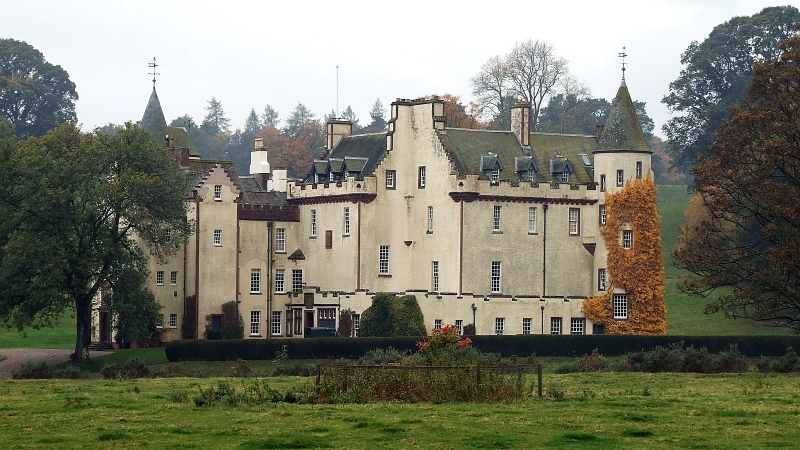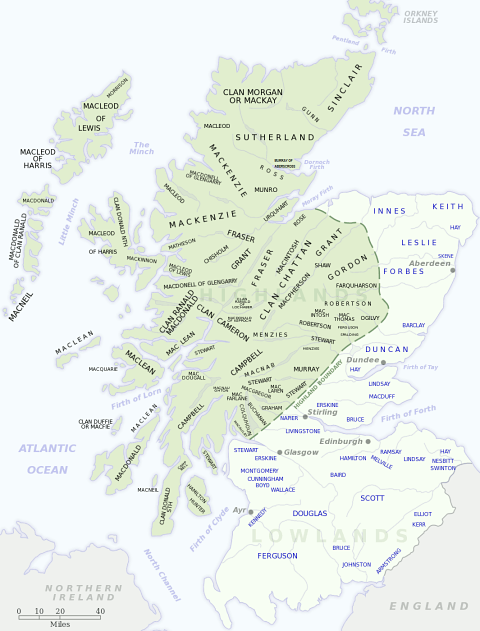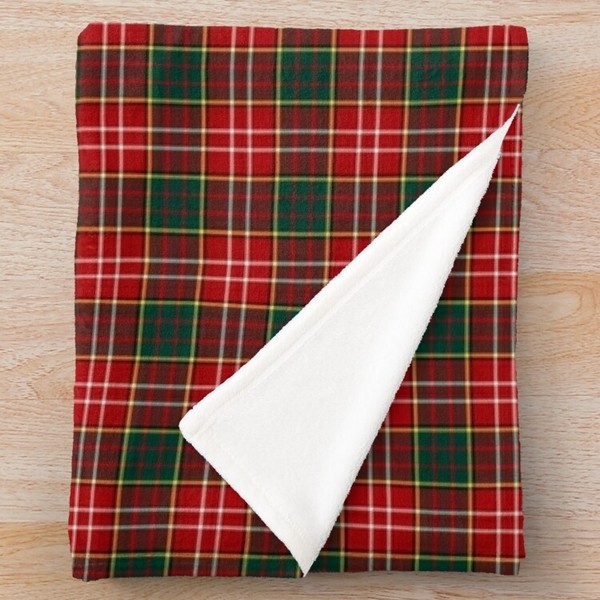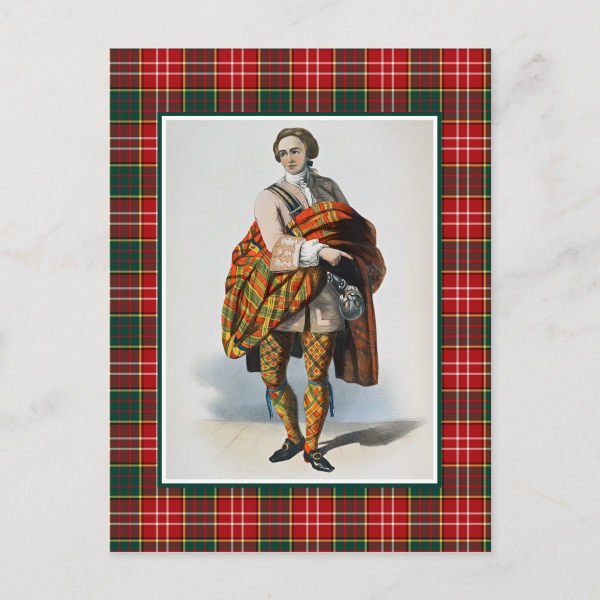
Motto: A Fin (To the end)
Historic Seat: Airlie Castle, Cortachy Castle (1473)
District: Angus
Associated Surnames: Airlie, Findlater, Gilchrist, MacGilchrist, Milne, Richardson, Storie
Associated Tartans:
Early Ogilvie Genealogy and History:
(Excerpt from "The Scottish Clans and Their Tartans", James Grant, 1906)
According to Douglas, the Ogilvies are descended from a certain Gilbert, second son of Gilibred, an Earl of Angus in the days of William the Lion, who witnessed many charters to the Abbey of Arbroath, and assumed the name of Ogilvie from his lands and barony so called. Patrick of Ogilvie, his grandson, was forced to swear fealty to the invader, Edward of England, for his lands in Forfar in 1296.
In 1309 Robert I granted a charter to Patrick of Ogilvie of the Barony of Kettenes in Forfar. Walter Ogilvie of Wester Pourie was Hereditary Sheriff of Forfar, and in 1385 obtained from Robert II a money grant from the thanedom of Kinalty, Forfarshire. His son, Walter Ogilvie, was also High Sheriff of Forfar, and lost his life in 1391, in a conflict with Duncan Stewart, a natural son of the Earl of Buchan, who invaded the county to burn and pillage. The Sheriff overtook them at a place called Glenberrith, and in the fight that ensued he fell with his brother and sixty of his clan.
The line of Sir Alexander, eldest son of Sir Walter Auchterhouse, ending in a daughter, who became Countess of Buchan, Sir Walter Ogilvie of Lintrathen, second son of Sir Walter of Auchterhouse, became the head of the family. He was Lord High Treasurer under James I in 1425, and a Commissioner for renewing the truce with England in 1431. He married Isobel Durward, the heiress of Lintrathen, by which his posterity were designed till raised to the Peerage, which was the fortune of his grandson, Sir James, who after guaranteeing a Treaty of Peace with England in 1484, was made a Lord of Parliament in 1491 by James IV, as Lord Ogilvie of Airlie. He died in 1504.
James, sixth Lord Ogilvie or Airlie, was a loyal subject to Queen Mary, for which he suffered long imprisonment, but was released by James VI in 1596, and sent Ambassador to the Court of Denmark to assist at the coronation of Christian IV. He died in 1606, and was succeeded by his son James, who married a daughter of William Earl of Gowrie.
James, eighth Lord Ogilvie, for his loyal and gallant services to Charles I, was created Earl of Airlie in 1639, and became as a Royalist very obnoxious to the Scottish Parliament, against whom his second son, Sir Thomas, levied a regiment, at the head of which he fell at the battle of Inverlochy.1 James, second Earl of Airlie, by his valour contributed to the defeat of the Covenanters on more than one occasion, but was taken prisoner at Philiphaugh,2 and sentenced to death. He effected his escape form the Castle of St. Andrews in his sister's clothes, and was afterwards pardoned.
James, Lord Ogilvie, was "out" for King James in 1715, and, dying without issue, was succeeded by his brother John, as fourth Earl of Airlie. His son, afterwards fifth Earl, was a devoted adherent of the Royal family, and joined Prince Charles at Edinburgh in 1745, with 600 men, principally of the Ogilvie clan. He marched to Derby, fought at Falkirk3 and Culloden,4 after which he retired to Norway, where he was made prisoner, but escaped to Sweden, and became an officer in the French service. He returned to Scotland in 1783.
Walter Ogilvie of Airlie assumed the title in 1812, but the Earldom was not restored by law till 1826. The present Earl and Chief is the ninth Earl. The first ancestor of the Ogilvies, Earls of Findlater, was Walter, a son of Sir Walter Ogilvie, who, as stated, married Isobel Durward, the heiress of Lintrathen. He obtained charters under the Great Seal of the baronies of Deskford and Findlater in 1440. James, his heir, was knighted by James III, and his second son was Sir Walter of Boyne, from whom the Lords Banff and Ogilvie of Strathearn, Lord High Treasurer of Scotland in 1516 were descended.
Sir Walter Ogilvie, seventh of Findlater and Deskford, was created by James VI in 1616 Lord Ogilvie of Deskford, and his son was raised to the Earldom of Findlater by Charles I in 1638. Having no male heir, he obtained a new patent conferring the title of Findlater after his death on his eldest daughter, Lady Elizabeth, and her husband, Sir Patrick Ogilvie, who married the heiress of Sir John Glen, whose ancestor got that estate by marriage with the daughter of Sir Patrick Inchmartin of that Ilk who was secretary to Robert I, and was killed at the battle of Dupplin5 in 1332.
James, fourth Earl of Findlater, born in 1664, was appointed Secretary of State by King William in 1695, and in 1701 was created Earl of Seafield. In 1704 he was Chancellor and a promoter of the Union. He sold his vote for £100. James, fifth Earl of Seafield and Findlater, was Vice-Admiral of Scotland in 1737. James, seventh Earl of Findlater, and fourth Earl of Seafield, left no issue by his Countess (a daughter of Count Murray of Melgum), and at his death in 1811 the Earldom of Findlater expired; but the other dignities reverted to his cousin, Sir Lewis Alexander Grant of that Ilk, Bart.,6 who then added to his own the name of Ogilvie.
The Ogilvies of Dunlugus were first Baronets in 1627, and in 1642 created Lords Banff for the loyal services of Sir George Ogilvie, who fought at the Bridge of Dee in 1639. The title has been dormant since the death of William eighth Lord, in 1803. John Ogilvie of Inverquharity was created a Baronet in 1627, and George Ogilvie of Barras (for defending Dunottar against the English) in 1661. Title extinct. In 1684 Ogilvie, the Laird of Logie, was brought before the Privy Council for shooting Alexander Leslie, writer, in a jealous quarrel. He was fined £200 sterling, and remitted by the King, though the Chancellor alleged that Ogilvie waylaid Leslie "and the proditoriously (sic) murdered him." In the same year Francis Ogilvie of New Grange was "pursued" by the Lords of Council for the forcible abduction of the daughter of David Scott of Hadderwick. David Stuart Ogilvie of Corrimony, who had served in the Crimean War, joined the army of the Loire during the Franco-Prussian War, and gave, it is said, Gambetta a plan of the campaign. He died of wounds in action, in 1870, when Capitaine d'Etat-major of the 19th Corps d'Armée.
(End excerpt)
Next page: Clan Robertson
Footnotes:
1 The Battle of Inverlochy (1431): The Battle of Inverlochy was fought by a force of Highlanders led by Donald Balloch, and Royalist forces led by the Earls of Mar and Caithness at Inverlochy, near present-day Fort William. Read more about the Battle of Inverlochy at Wikipedia.
2 The Battle of Philiphaugh (1645): The Battle of Philiphaugh was fought on 13 September 1645 near Selkirk in the Scottish Borders between the Royal army of James Graham, 1st Marquis of Montrose and the Covenanter army of Sir David Leslie. Read more about the Battle of Philiphaugh at Wikipedia.
3 The Battle of Falkirk Muir (1746): The Battle of Falkirk Muir was fought on 17 January 1746 between the Jacobites under Prince Charles Edward Stuart (Bonnie Prince Charlie) and a government army commanded by Lieutenant General Henry Hawley. Read more about the Battle of Falkirk Muir at Wikipedia.
4 The Battle of Culloden (1746): The Battle of Culloden was fought on 16 April 1746, on Drummossie Moor, near Culloden, east of Inverness Scotland, between Scottish forces led by Charles Edward Stuart (Bonnie Prince Charlie) and English forces led by William Augustus, Duke of Cumberland. It was the final confrontation of the Jacobite rising of 1745. Read more about the Battle of Culloden at Wikipedia.
5 The Battle of Dupplin Moor (1332): The Battle of Dupplin Moor was fought 10-11 August, 1332, near Perth, Scotland between supporters of the infant David II, son of Robert the Bruce, and rebels supporting the Baliol claim to the throne. It was a significant battle of the Second War of Scottish Independence. Read more about the Battle of Dupplin Moor at Wikipedia.
6 Bart.: Baronet

Distribution of Scottish clans and families
View larger map at Wikimedia Commons

Browse the Clan Ogilvie Tartan Collection with fabric, home decor, accessories, electronics cases, and more.

Browse the Angus District Tartan Collection with clothing, home decor, accessories, electronics cases, and more.

Clan Ogilvie Postcard: Digitally cleaned and enhanced vintage illustration with tartan border.